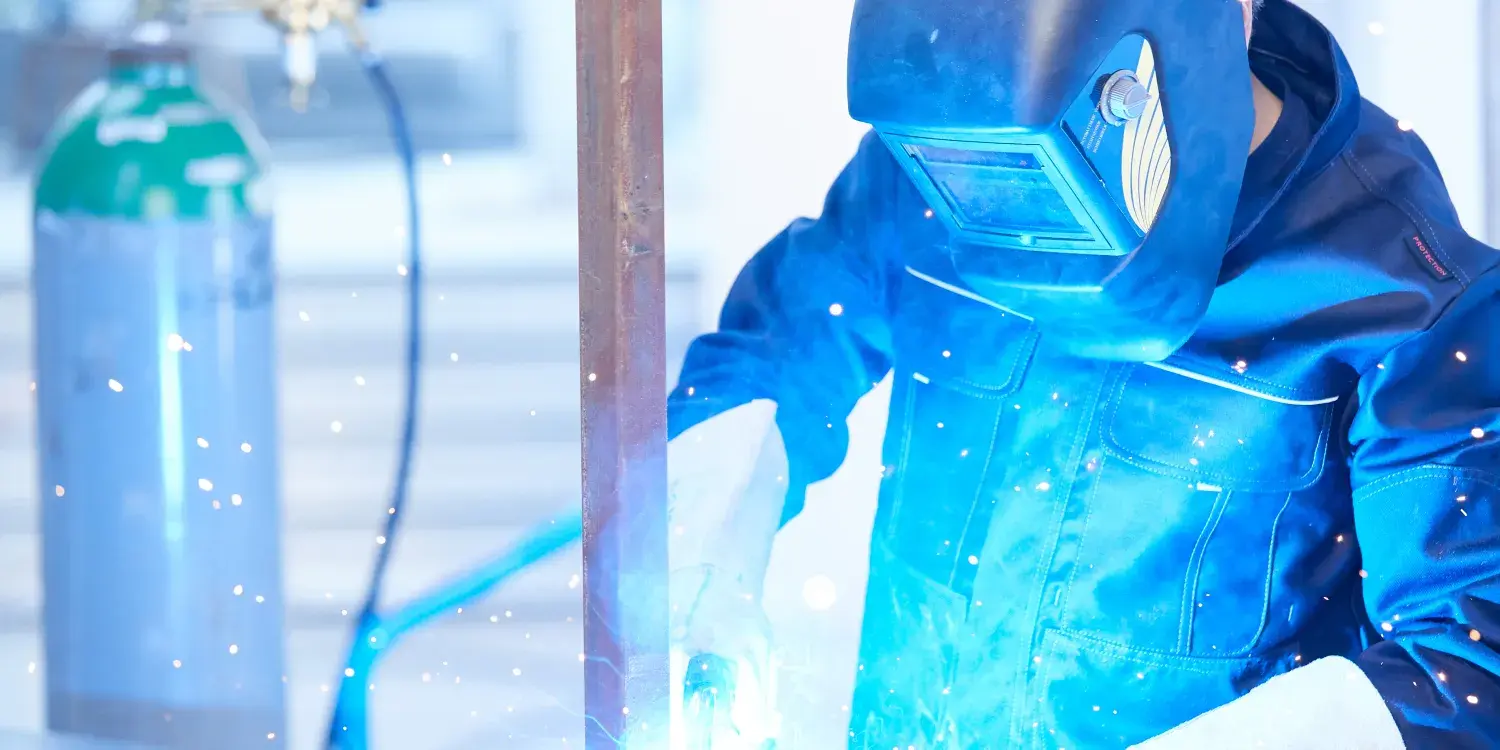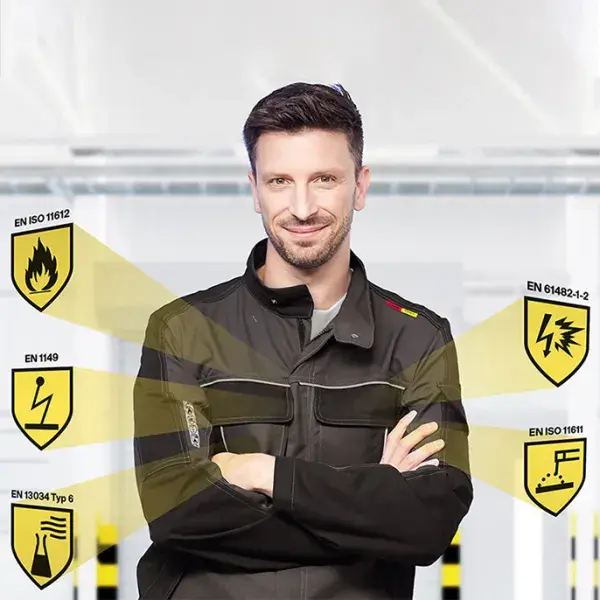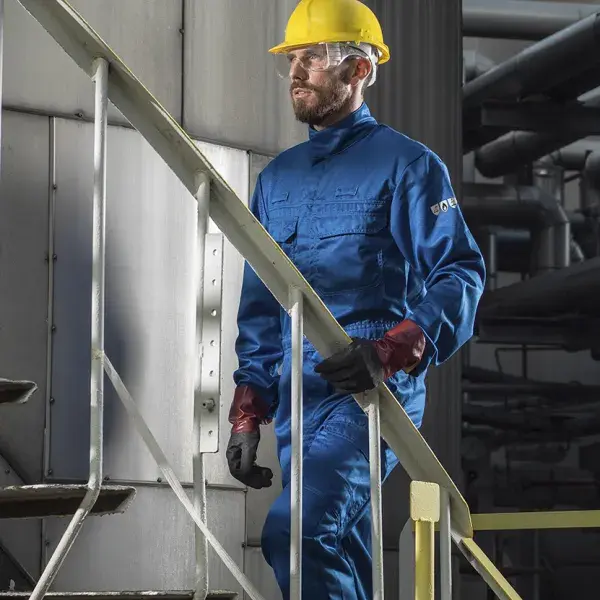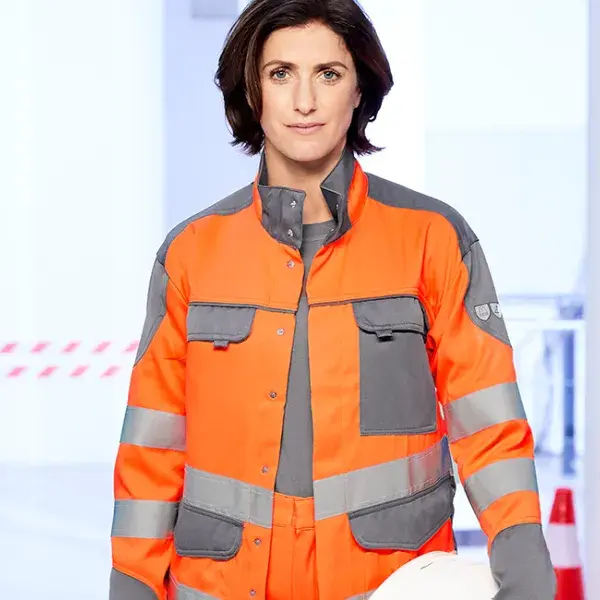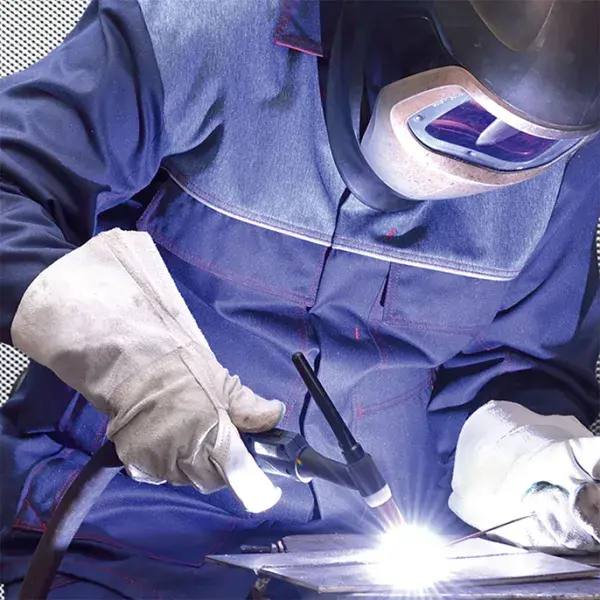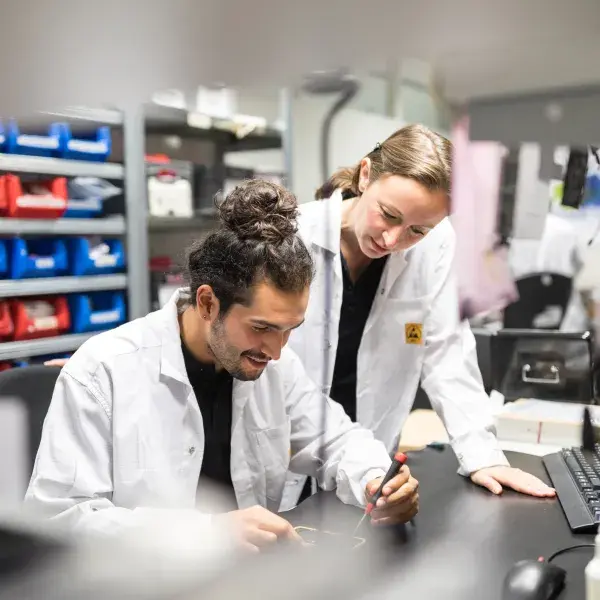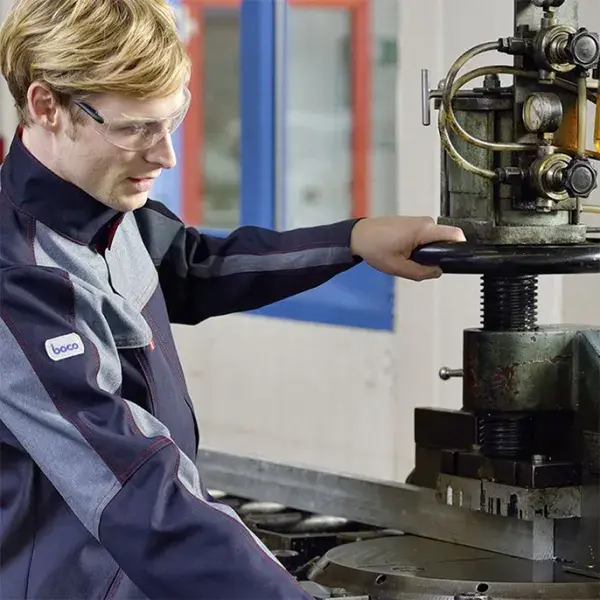Personal protective equipment
For a safer working environment
Thousands of occupational accidents are reported every year, many of them are avoidable. We want your employees to return home healthy at the end of a working day. This is why we offer the protection they need: functional and needs-based protective clothing.
Our range of regulatory compliant collections is large - from high-visibility and weatherproof clothing to protective clothing for welders. We not only provide the PPE, we also collect it from you, repair it, and return it clean and good as new. Only regularly professionally reprocessed PPE can retain its protective efficacy. For this, you can rely on the professionals from CWS.
Download (German catalogue)
Personal protective equipment (PPE) from CWS - this is why it pays to work with us
Standard-compliant occupational safety
As an employer, you must provide your team with the necessary protective clothing. Violations can result in heavy fines. CWS works with you to select the right PPE protective equipment, advises you through the jungle of standards and ensures compliance with all regulations.
Certified processing
Only professionally reprocessed PPE permanently fulfills legal requirements. We offer a certified process according to strict procedures and are responsible for ensuring that all protective functions are maintained, thus guaranteeing your occupational safety. Defective clothing is sorted out.
Good quality is not a coincidence
We leave nothing to chance in product development. All products have to pass tough tests. For example, we check the reflectors of high-visibility clothing just as carefully as the electrostatic dissipation of ESD clothing.
PPE with a feel-good guarantee
When protective clothing is worn all day, the wearer should feel comfortable in it. It must be comfortable and breathable, and offer sufficient freedom of movement. In addition to regulations, CWS pays attention to good fit and comfort.
FAQ
Do you have questions about personal protective equipment (PPE)? We have the answers. If you still have questions, we are always happy to help. Choosing the right PPE requires a lot of consultation; we will be happy to take the time for you.
Why should you wear protective clothing?
There are jobs where the worker's health is at risk. Think of work with chemicals, pesticides, liquid metal or electricity. Legislation has been enacted for hazardous work such as this to minimise the dangers to the worker and to place the responsibility for the protection of employees with the employer.
Protective clothing offers protection against the risks and dangers of a workplace. It serves the purpose of occupational safety. Unlike casual or personal clothing, protective clothing can eliminate many hazards and protect the worker from devastating injuries and accidents. Even if the likelihood of an accident or injury seems low at first glance, if you consider how serious, sometimes even fatal, an accident at work can be, protective clothing should always be worn for your own safety. Because protective clothing only protects if it is worn (correctly).
By the way: There are workplaces where the working environment must be protected from the worker by protective clothing. ESD clothing, cleanroom clothing or surgical clothing are examples of this.
Protective equipment - what is it?
There are basically seven different types of protective equipment for hazardous workplaces: Respiratory protection, eye protection, hearing protection, head protection, hand protection, foot protection and torso protection - i.e. protective clothing. We speak of personal protective equipment (PPE for short) when special personal equipment is required by law for work that is potentially hazardous to health. This equipment includes, for example, work clothing, work tools or special work objects.
The PPE Regulation (EU) 2016/425 has a direct legislative character. According to it, PPE must be worn if workplace risks cannot be eliminated otherwise (e.g. through technical or organisational measures). The basis for wearing personal protective equipment is laid by an individual risk assessment of the workplace.
What does personal protective equipment mean?
Personal protective equipment refers to all equipment that serves the safety and health of employees. This includes, for example, safety helmets, safety glasses, hearing protection, respirators, safety shoes, protective gloves, protective clothing, life jackets or cut protection clothing.
The addition of "personal" states that PPE must always be used on a personal basis. For example, pool clothing is not permitted. Each employee must be provided with his or her own protective equipment. Those who suspect hygienic reasons behind this requirement are not entirely wrong. If masks or hearing protection were to be used jointly, this would entail undesirable health risks. But not only hygiene aspects play a role in equipping workers with "personal" protective equipment. Protective clothing must also fit correctly - and that is only possible individually, i.e. "personally". Sleeves and trouser legs must not be too long or too short, jackets must close completely, and the clothing must not have any damaged spots that impair the protective properties. The functionality and perfect hygienic condition of the PPE must be guaranteed for every work assignment.
What is part of the protective equipment?
Protective equipment includes all clothing and objects that serve to protect the safety and health of workers. This may include respirators that protect against airborne pollutants. The eyes can be protected from mechanical, optical, chemical or thermal effects with appropriate eye protection. Hard hats, bump caps, hair protection bonnets and hair protection nets protect the head from injuries during work. Feet and legs are protected with work and safety shoes or knee protectors. And special protective clothing protects the employee's torso, arms, legs and hands from occupational accidents and hazards.
Who has to pay for personal protective equipment?
The German PPE Use Ordinance (PSA-BV) stipulates that personal protective equipment (PPE) must be procured, maintained, stored and provided by the employer. According to § 3 para. 3 ArbSchG, the employer must in principle bear all costs incurred. Similiar regulations apply for other European countries.
What is not part of PPE?
Personal protective equipment serves to protect the safety and health of employees. Work clothing and uniforms that do not specifically serve safety and health protection do not count as PPE according to §1 para. 23 PSA-BV. According to this understanding, employees of emergency and rescue services do not wear PPE. Uniforms that are not considered "personal protective equipment" (PPE) are also worn in the armed forces, by the police or other institutions that serve public safety and order. The decisive factor for classification as PPE is in particular the purpose of the clothing. An emergency paramedic, a policewoman or an employee of the public order office wear uniforms that serve the purpose of quick recognition and affiliation to a certain occupational group, but which do not primarily serve their own safety or protect their own health.
What protective clothing is available?
There is a wide range of workplaces where protective clothing must be worn. Accordingly, there are many types of protective clothing: There is protective clothing for machines, which protects against being caught by moving machine parts. There is protective clothing against contact with flames or heat radiation (also called radiant heat). There is protective clothing for workplaces where welding takes place, which protects against metal splashes and UV radiation. There is chemical protective clothing and protective clothing for the application of plant protection products.
There is special protective clothing that protects against electric arcs when working on live parts. And there is antistatic protective clothing. This clothing prevents static electricity from discharging with sparking, which could potentially cause fire or explosions.
What are the different types of PPE?
PPE or personal protective equipment is divided into the following types: respiratory protection, eye and face protection, foot and knee protection, hearing protection, hand protection, skin protection, head protection and PPE against falls from a height. See also "What is protective clothing?" and "What belongs to protective equipment?
How can CWS Workwear support me with matters concerning PPE?
The legislature imposes numerous regulations on the use of PPE. This begins with the selection of suitable clothing for employees. Without professional support, it is virtually impossible for companies to comply with all the regulations. The easiest and safest way is therefore to work with a specialist like CWS. CWS not only assumes legal responsibility, but also ensures that the protective clothing is washed and maintained professionally by trained personnel.
Which laws must be taken into account?
The Occupational Safety and Health Act (ArbSchG) obliges the employer to take all necessary measures to ensure the health and safety of their employees.
The Occupational Safety and Health Act also includes the PPE Usage Ordinance. Directive 89/656/EEC defines the use of PPE in more detail. It regulates the selection, provision, maintenance, repair, replacement and storage of PPE. Since April 2018, the new Europe-wide PPE Regulation 2016/425 has also been in force.
What is a declaration of conformity and the manufacturer’s information and where can I find these documents?
Since the PPE Regulation 2016/425 came into force, companies are now obligated to present two documents during inspections: a declaration of conformity and the manufacturer's information. PPE manufacturers must make both documents available.
With the declaration of conformity, the manufacturer confirms that their products comply with the relevant legal regulations. In addition to the name and full address of the manufacturer, the manufacturer's information includes all necessary information on the use, storage, cleaning, servicing, maintenance and disinfection of personal protective equipment.
When purchasing PPE, make sure that the manufacturer provides you with these documents. With CWS, you will receive both documents upon finalisation of the contract.
How long does protective clothing last?
CWS produces high quality protective clothing that lasts for a long time. In addition, we regularly maintain and care for the clothing in a professional manner, which means that it has longer operating cycles than purchased PPE.
Can protective equipment be used for different activities?
We recommend using the appropriate protective clothing for each application. There is also multifunctional protective clothing that offers protection against different several hazards. CWS offers PPE that includes welding protection, heat and flame protection, chemical protection and arc protection, which also has electrostatic properties. Demanding welding work requires protective clothing that meets special requirements. The material must have flame-retardant properties that prevent afterburning and melting on the clothing.
Sometimes, though, your products need protection as well as your employees. Employees in component production therefore need ESD protective clothing to protect sensitive components from electrostatic discharge during production.
Can defective protective clothing be repaired or must it be replaced?
Damaged PPE can be repaired. However, specialist knowledge is required to ensure that its protective properties are not impaired. Any change to the clothing is subject to strict specifications. For example, only specific flame-resistant yarns may be used to repair heat protective clothing. CWS is specialised in the repair of PPE. Our trained personnel work according to certified procedures and repair PPE in accordance with legal requirements. If PPE is worn out completely and can no longer be repaired, we will replace it. In this way, our customers always receive consistently high quality standards for PPE.
Does the protective function remain intact after washing?
Only professional washing processes can guarantee the efficacy of protective functions. This involves matching the water temperature and detergent to the PPE materials. For this reason, PPE should never be cleaned in a conventional washing machine. This can be dangerous. For example, if heat and flame protective clothing is treated with fabric softener, the material can easily ignite. If water and dryer temperatures are too high, the luminosity of reflectors can be lost. Some items of clothing that are intended to protect against rain or chemicals also require a so-called hydrophobisation, a kind of impregnation, after the washing process. This can only be done by certified laundries.
Can protective clothing be provided with a company or name badge?
In principle, certified PPE may not be modified if this could compromise safety. For this reason, strict guidelines must be observed when affixing badges or emblems. For example, the emblems must be made of suitable flame-resistant materials and exact positioning must be taken into account. It is therefore recommended that the application of emblems is always carried out by a professional with the appropriate experience. CWS offers its customers this service and ensures that the protective clothing always complies with the assigned standard.
Additional solutions and services for you
Washing and cleaning workwear
Environmental protection is important to us. We focus on saving water when reprocessing PPE.
Workwear selection
CWS offers a wide range of workwear for almost all industries and activities.
Clothing management
We offer everything you need from wardrobe service to complete clothing management.
